Nemanja Matic recently signed a new three-year deal at Manchester United, which keeps him contracted at Old Trafford until 2023.
Roughly around the same time as Matic signed, Scott McTominay also signed a new deal at Manchester United, extending his stay with the Red Devils until June 2025.
There has been quite a debate amongst United fans and football pundits alike
over whether or not McTominay is capable of fulfilling the role that the left-footed Serbian has done for Manchester Unitedthroughout his three seasons in Manchester.
Certain commentators have urged Manchester United to scout for a new replacement for Matic, who is on the wrong side of thirty years of age.
A player along the lines of Wilfred Ndidi or Thomas Partey would be a fitting replacement for him.
However, a large chunk of the Manchester United fanbase believes that Scott McTominay would be a perfect replacement to gradually pick up the baton from Matic over the Serb’s remaining years at the club.
This article will be a tactical analysis, trying to settle this debate
. Using data analysis as well as match footage, it will examine whether Scott McTominay is really capable of taking over Manchester United’s demanding defensive midfield role andsucceeding Nemanja Matic.
Scott McTominay Roles in the build-up phase
Under Manchester United’s Norwegian manager, the midfield pivot player has been an essential part of Ole Gunnar Solskjaer’s formation.
Far more important than it was in his predecessor’s tactical system, Jose Mourinho.
Solskjaer deploys a 4-2-3-1 formation, which means that United play with a double pivot in central midfield.
Many top sides, including Man City and Liverpool, only use a single pivot.
The double-pivot relieves the pressure of a single pivot and shares the responsibility, whether offensively or defensively.
Offensively, Matic is essential for Manchester United in allowing them to build through the thirds using their possession-based style of football.
Pogba operates in the space between the opposition’s midfield and forward line.
Matic sits alongside Pogba in this space, however, if two centre-forwards are marking Manchester United’s centre-backs, Matic will drop and become a third centre-back.
This prevents United from being outnumbered by the forward press.
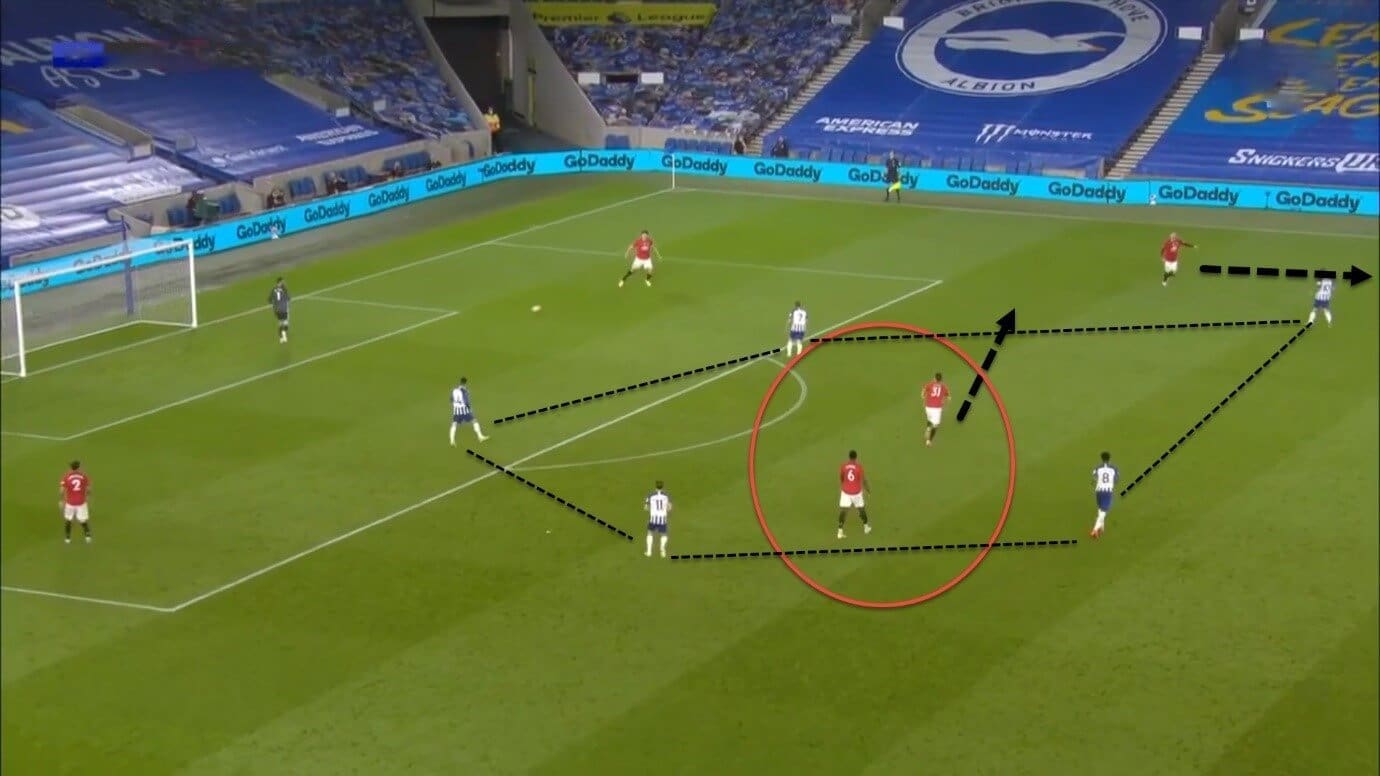
Matic has dropped in as a third centre-back in this footage, as Brighton have marked both of United’s centre-backs.
This also allows the left-back to advance further up the field.
In contrast to Matic with Scott McTominay, Solskjaer doesn’t entirely trust him to fulfil this role on his own.
In the 2019/20 season, McTominay has predominantly lined up in the double pivot next to Fred.
Fred is generally the player tasked with dropping into the area beside the centre-backs and sometimes between them.
This is due to his vast experience in fulfilling this role at Shakhtar Donetsk.
Matic usually stays in the space behind the forwards to act as the passing option to split the opposition forward line.
However, he also can push up beyond the opposing midfield line to act as a progressive passing lane.
McTominay has an excellent ability to take a pass on the half-turn and drive with it.
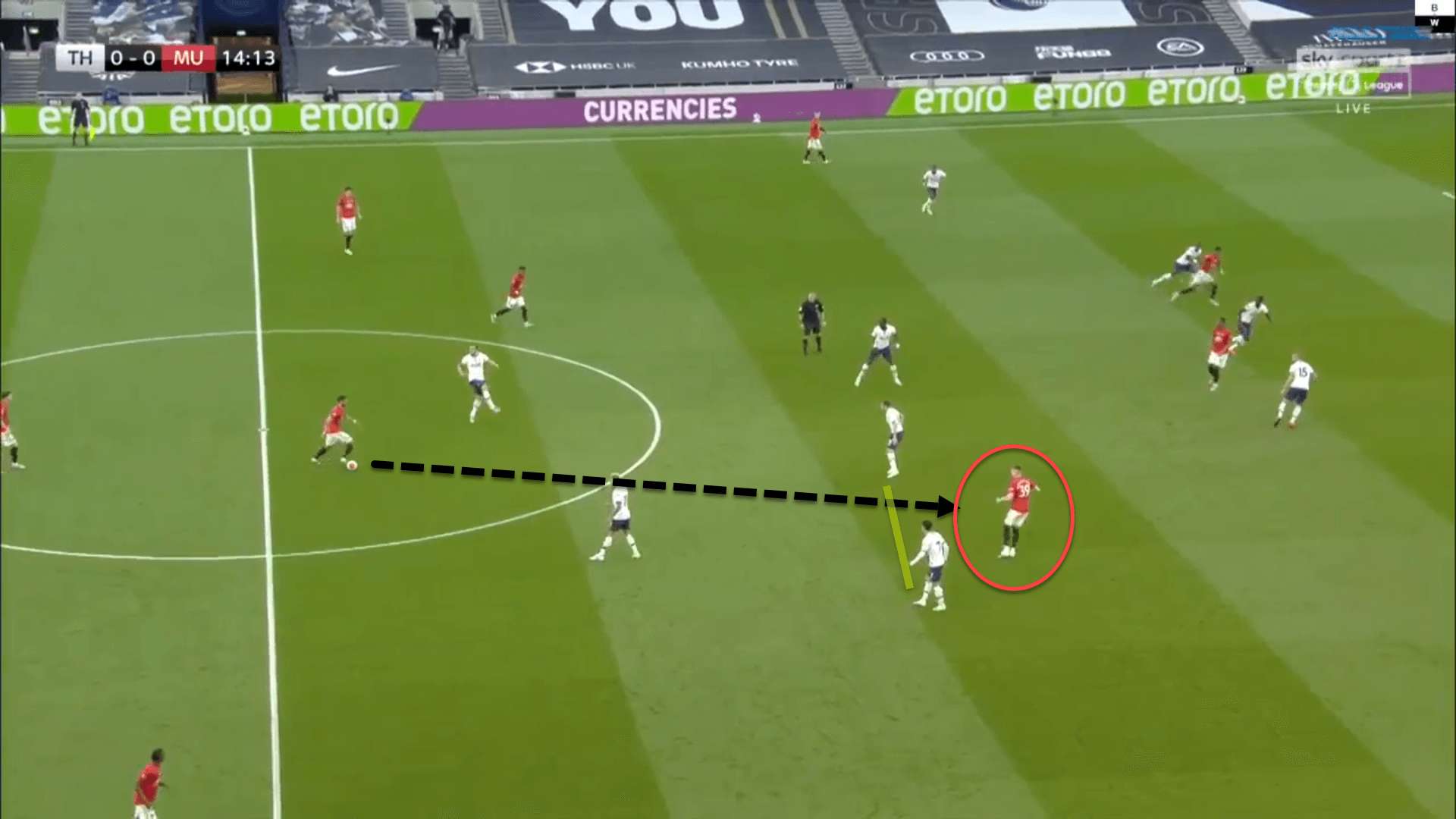
Scott McTominay’s Offensive role
McTominay is clearly a far better option going forward for Manchester United, notably in the final third.
Over the course of the season, he has compiled a shot tally of 55 shots on goal, compared to Matic’s 12.
McTominay has also completed 3.75 dribbles per game and has a success record of 62.5%, similar to James Maddison.
Matic has completed just 1.72 dribbles per 90, with a success rate of only 48.48%.
McTominay plays a box-to-box midfielder role for Manchester United.
This means that even if United loses the ball high up the pitch, he is primed to counter-press and put United on the front foot again.
By doing so, he covers a substantial amount of ground per 90 minutes for United and is more efficient in terms of his ball recoveries than Matic.
In the final third, he has completed 56 recoveries, 36 of which are in vital Zone 14.
10 have led to shots, which includes one goal.
38 of these recoveries were counter-pressing recoveries.
He is crucial for United in our defensive transitions, boasting a total of 170 counter-pressing recoveries, which can be seen here;
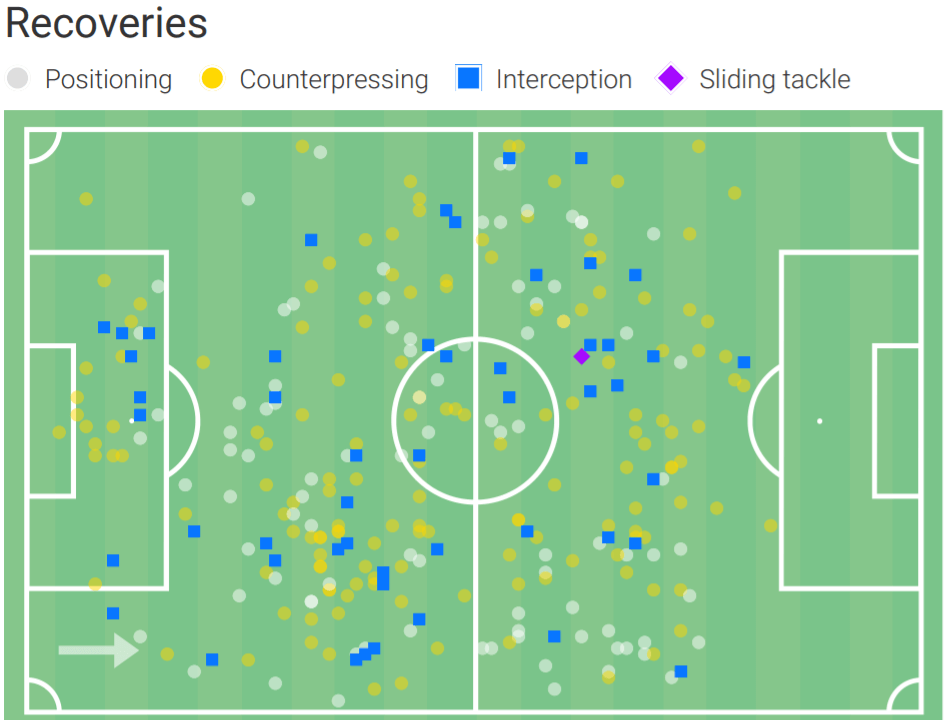
However, Matic is far more important in possession for Manchester United than McTominay.
As stated before, Matic is deployed as part of United’s double pivot.
He drops into the backline to become a third centre-back.
This is because of his excellent ability to progress the ball through the thirds.
Particularly the first third to the middle third.
Nemanja Matic ranked number eleven in average completed passes p/90 made by Premier League midfielders during the 2019/20 season.
He averaged 63.71 passes per 90 minutes and a pass completion rate of 88.27, which is vastly similar to Manchester City’s David Silva.
His progressive passing statistics are even more impressive for a defensive midfielder labelled as overtly defensive.
He averages precisely 8.78 progressive passes per 90.
He is also capable of making a pass into the final third that splits the opposition’s defensive line, too.
This can be seen in the following image, in which he sets Martial in behind Leicester with a split pass.
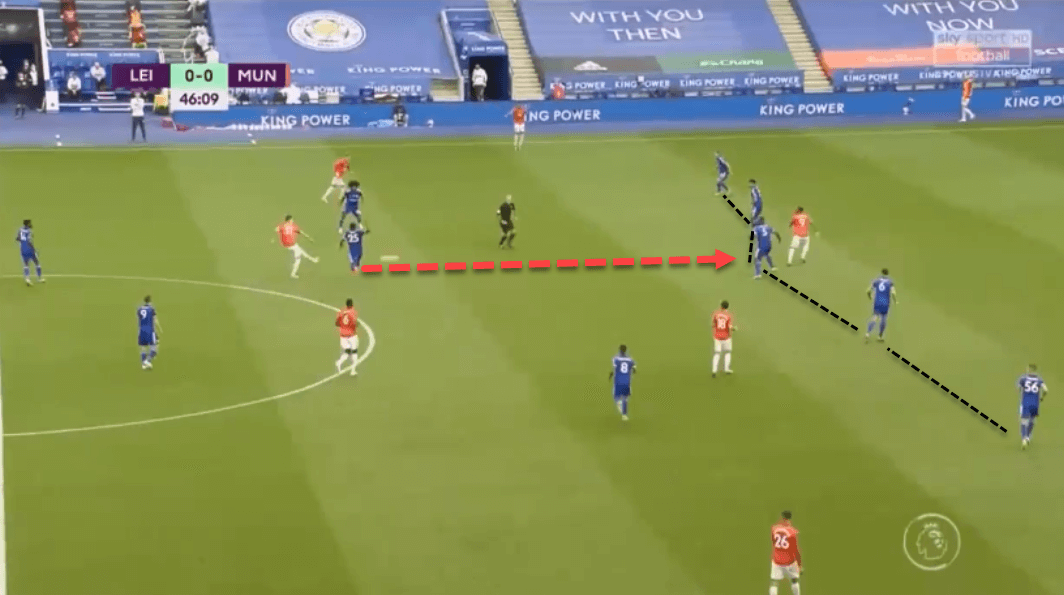
Nonetheless, these passes predominantly move United from the first phase into the second phase.
The phases of play are crucial for Solskjaer’s side due to their possession style of play.
The first phase occurs when the backline circulates the ball, searching for an opening through the opponent’s first line of defence.
This is where Matic is key.
He has an excellent passing range, which allows him to progress the ball into the second phase, preferably through Pogba.
However, he can also use the fullbacks in the wide areas if needed.
Once the ball is with Pogba behind the opposing forward line, United can look to commit players forward.
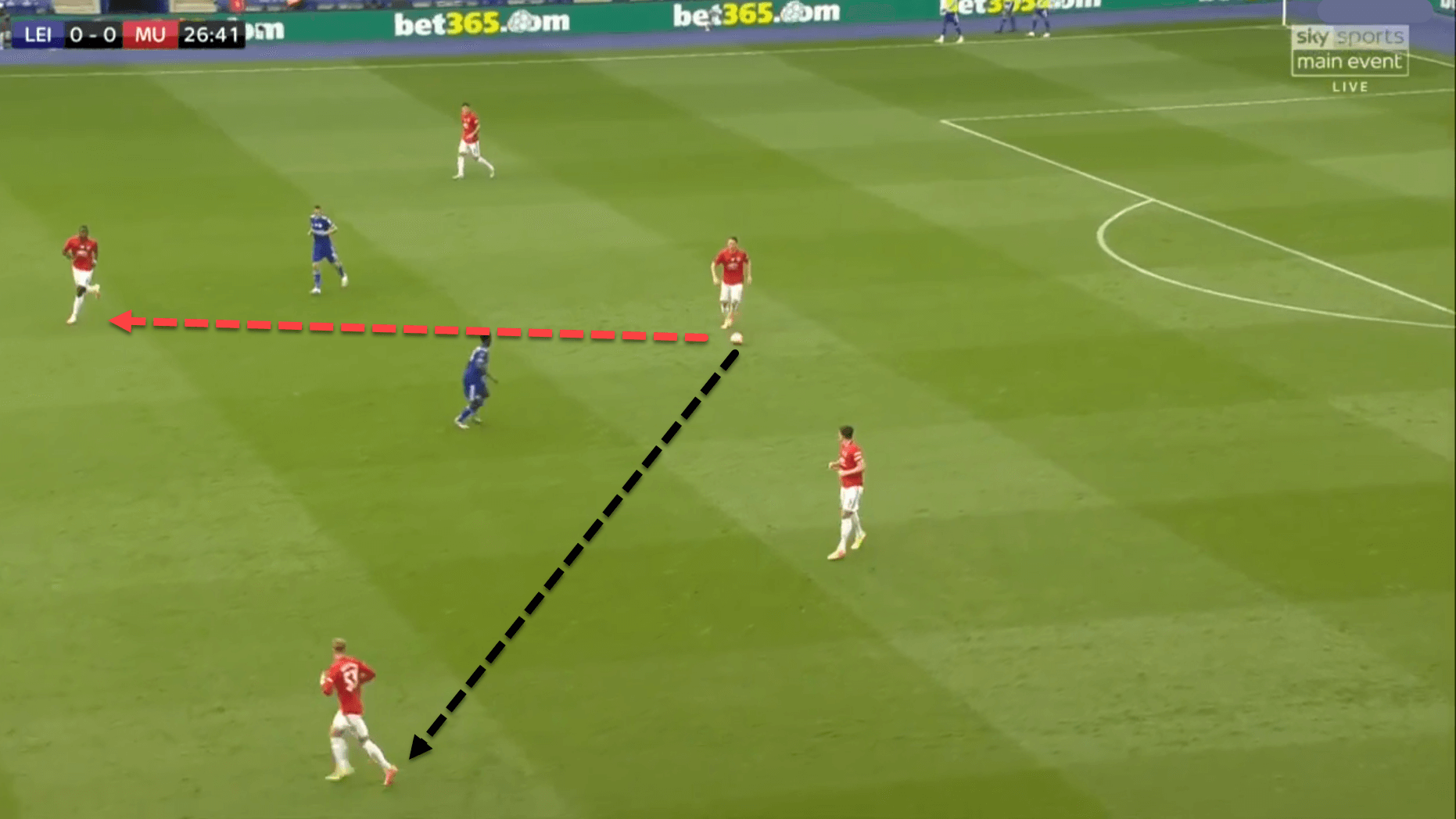
In the footage above, Matic has the choice of playing a progressive pass in the wide areas.
However, he instead opts for a progressive run in order to push past Leicester’s forward press.
This is another area where Matic surprisingly excels, as he is an excellent ball-carrier.
It is quite common for the Serbian international to bypass the opposition’s first line of defence.
He ranks 18th in the league in progressive runs per 90 for midfielders, with 2.51 per game.
His average progressive run distance is also substantially high, boasting a 97.12-metre distance with each progression.
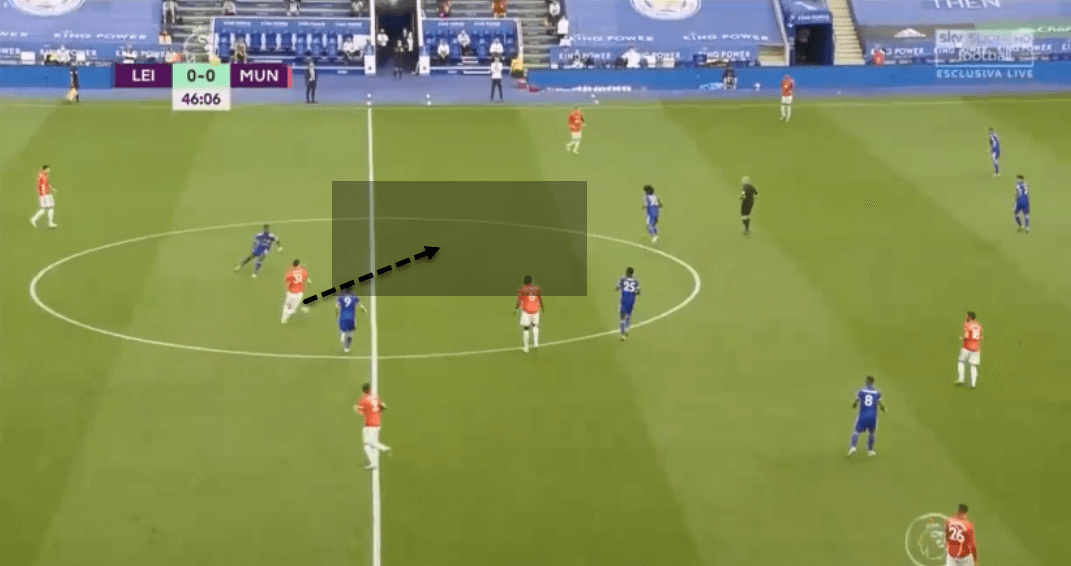
Above is one example of Matic completing a progressive run, driving from the backline into the area beyond Leicester’s forwards.
He is an excellent ball carrier despite not being a particularly mobile player.
He uses his body extremely well, shielding the ball if he is being closed down to hold off the oncoming pressing player.
Scott McTominay, in contrast, is quite a way off Matic with respect to these statistics.
McTominay completes under 1 progressive run per game despite having an excellent ball-carrying ability.
The exact statistic is 0.98 per 90 minutes.
He also only accumulates a total of 6.71 progressive passes per game.
In addition, the Scot falls short of the Serbian in terms of forward passes per 90.
Matic is averaging 20 forward passes per game, whereas McTominay is only averaging 14.
If McTominay is to take over Matic’s role as Manchester United’s defensive midfielder one day, he will have to improve significantly his passing stats, particularly in relation to playing more progressive passes and trying to help United play through the opposition’s lines with split passes, in order to progress them higher up the field.
Scott McTominay Protecting the backline
If McTominay is to become Manchester United’s new defensive midfielder, he will have to be very defensively sound and cover the backline exceptionally well.
Nemanja Matic excels in this role.
His defensive ability and presence allow Pogba to advance further up the pitch and link up with Bruno Fernandes.
Solskjaer trusts Matic to sit and screen the backline as the defensive midfielder, which allows United to commit men forward.
On average per 90, Matic wins 6.53 defensive duels, for Manchester United, with a 55.2% success rate.
Extraordinarily, Scott McTominay actually boasts a higher number of defensive duels than the Serbian.
McTominay wins 7.27 defensive duels per 90 minutes.
Even more impressive is his 60% success rate.
However, sometimes statistics can deceive us.
As I stated before, McTominay’s role as a box-to-box midfielder means he is tasked with counter-pressing the opposition.
He is also quite a combative midfielder who presses the opponent into more advanced positions, hence his higher number of defensive duels than Matic.
As a defensive midfielder, Matic has a higher defensive duels rate in the area just in front of the backline.
He has won 28 defensive duels this season from Zone 14.
In comparison, McTominay has only won 21.
When it comes to protecting the backline from danger, Matic is far superior to McTominay.
In terms of defensive intelligence, there is no competition between the two.
Matic has been influential for United in plugging the gaps in United’s defence.
In a defensive block, when one of the fullbacks or wingers has to push across to close down the ball carrier, gaps are left behind them.
One of two things can happen: Firstly, the entire defence can shift over to plug the gaps.
Or else, secondly, one of the defensive midfielders can drop into the space.
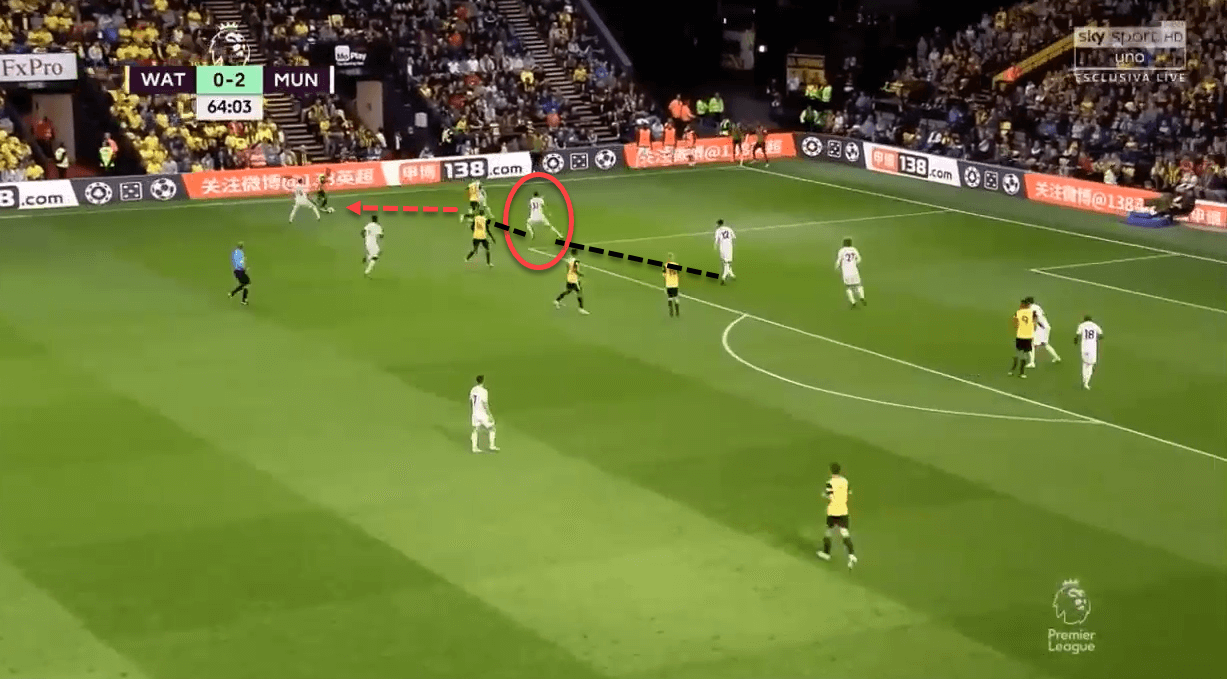
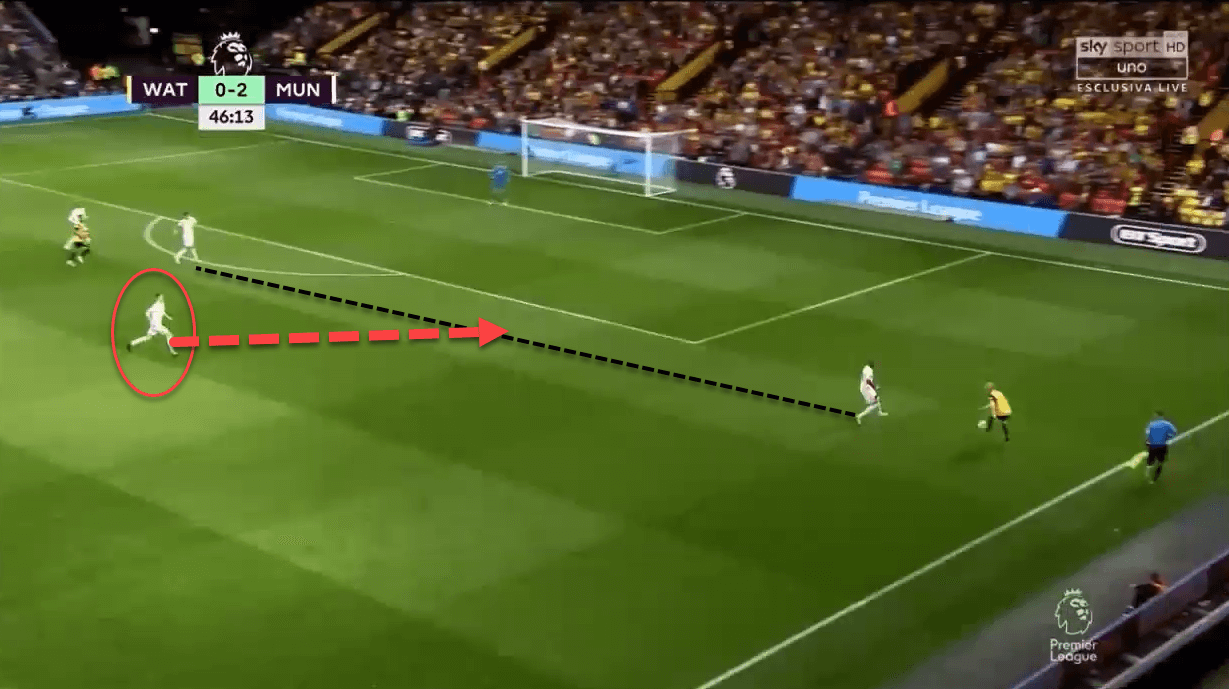
The images above are examples of Matic plugging the gaps in Manchester United’s defence successfully.
Instead of forcing the centre-backs to come across and cover the area, he uses his football intelligence to drop into the space.
This is to make sure that the defender he is covering is not vulnerable to a run-in behind on their blindside in the halfspace.
Scott McTominay is not quite as astute in these areas.
He is still young and learning his trade, so he may improve his defensive duties in these areas.
However, when he was deployed as a centre-back before, under former manager Jose Mourinho, McTominay struggled massively to cover the half-spaces and plug the gaps for his teammates.
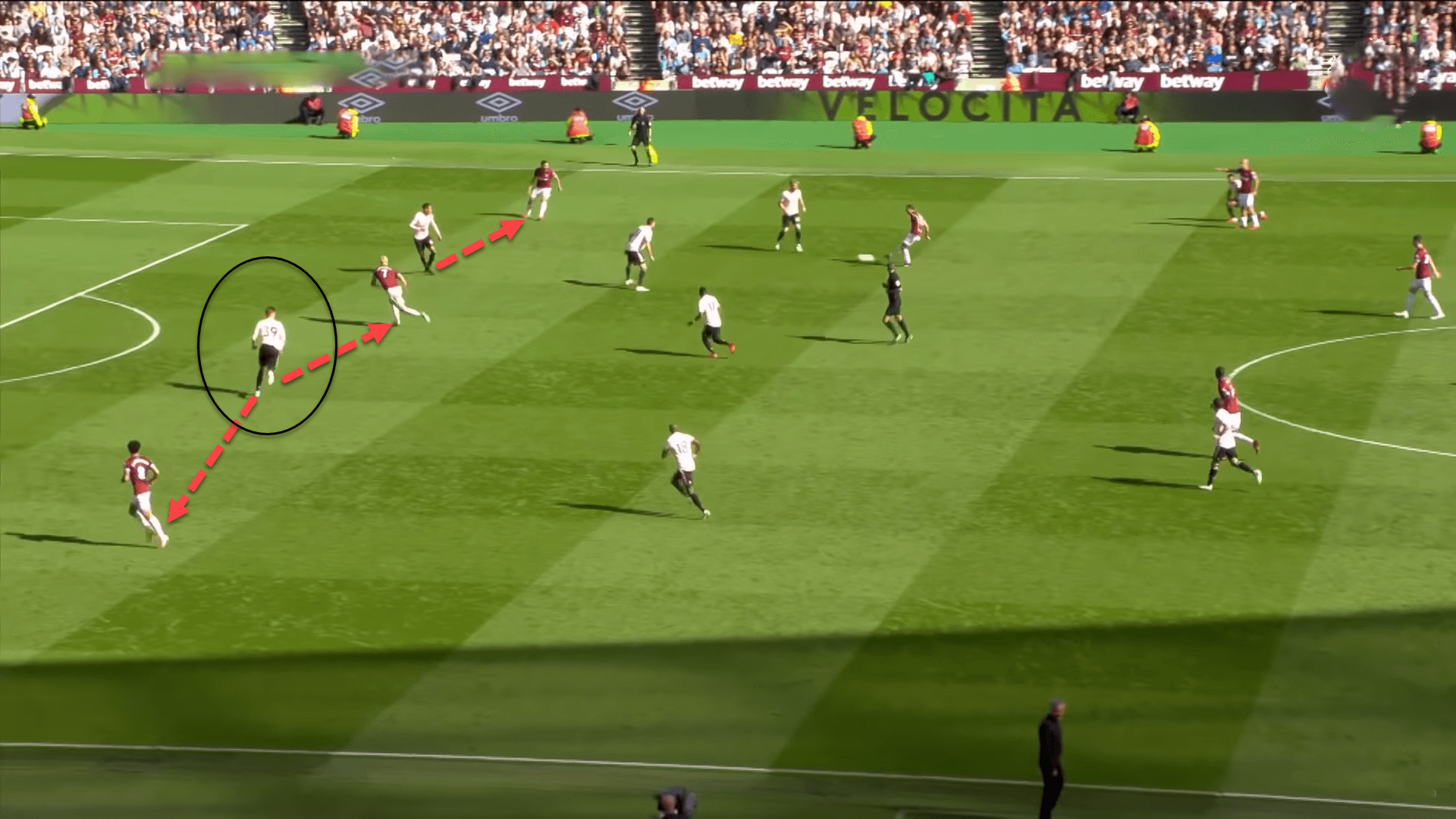
In the footage above, McTominay is unsure whether to close down the centre-forward or the winger.
The obvious choice was the centre-forward, who was clean through.
However, he stalled and failed to cover Smalling, who had to push across to cover Luke Shaw, and United conceded.
One area that McTominay does have an advantage over Matic is in his aerial duels.
Both players are roughly the same height, with McTominay standing at 193cm and Matic at 194cm tall.
McTominay is ranked 10th for Premier League midfielders in the average number of aerial duels, winning 4 per 90.
His success rate is 51.76%, in contrast to Matic, who only averages 2.93 a game.
If McTominay were to be deployed as a holding midfielder, he would be excellent for United at protecting their backline from long balls, particularly Lindelöf, who is nowhere near as physically gifted as Harry Maguire.
He is also far more mobile than Matic, so he would be fantastic at winning the second ball as well.
Conclusion
The point of this analysis article is not to make a biased decision over whether or not I believe McTominay is capable of fulfilling Matic’s duties as a holding midfielder.
The article’s purpose is to set out the facts and footage so that the reader can make an informed decision about this debate.
From the tactics and statistics, it is clear that McTominay has quite a long way to go before he reaches Matic’s defensive capabilities.
However, this does not mean that he will never be able to learn and grow into these capabilities.
McTominay is an excellent young and energetic midfielder.
He offers Manchester United a lot, particularly, with his abilities in defensive transition.
However, his decision-making is still quite raw.
If he is to permanently replace Matic, his decision-making and defensive intelligence will need to be improved over time.
Only time will tell whether or not United will look for an internal or external replacement for Matic.
At the moment, nobody in their squad is good enough to perform his roles as well as he does, and Solskjaer will be hoping to squeeze at least one more top-performing season out from him before being forced to look for a player to replace him.

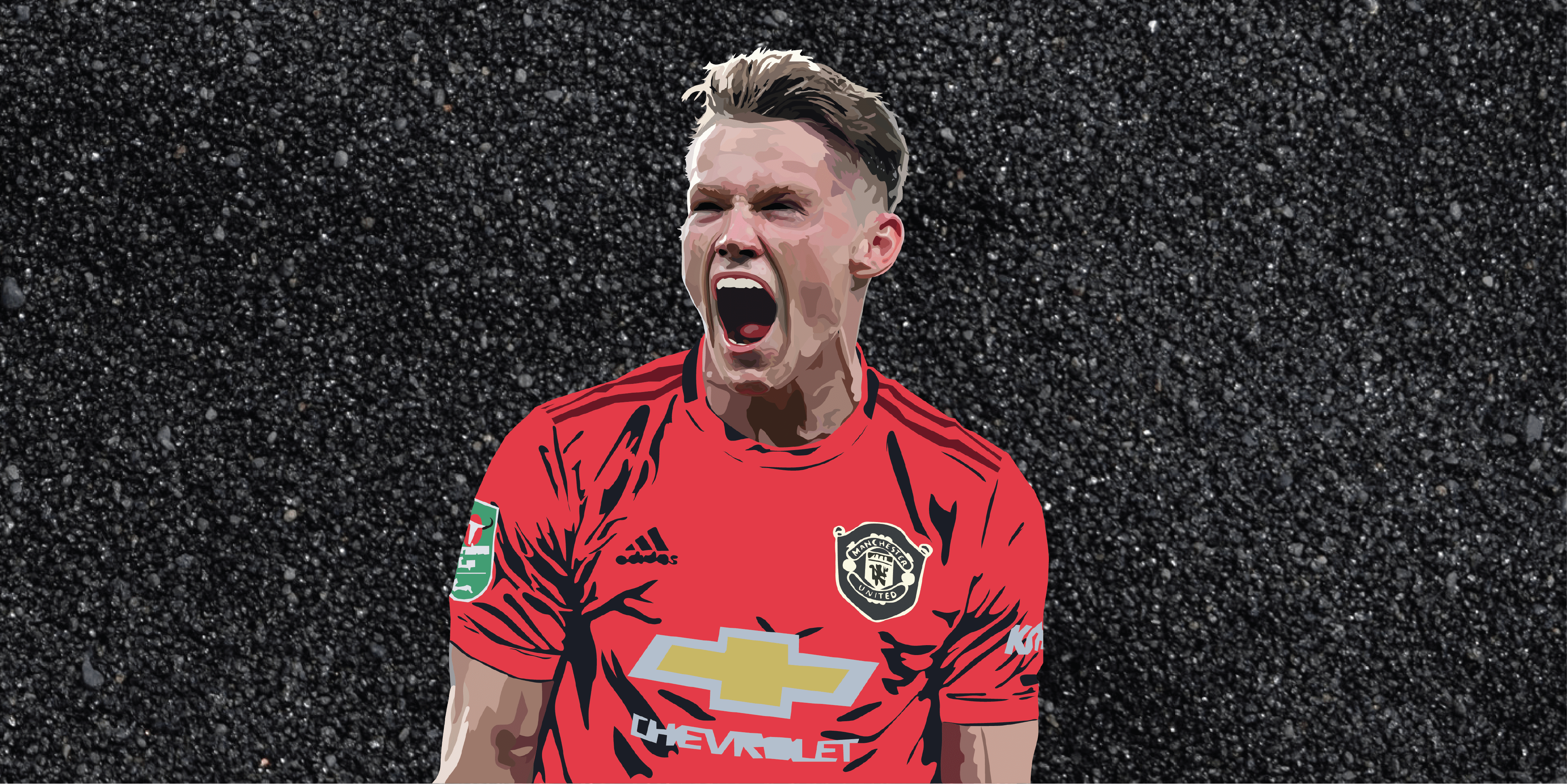




Comments